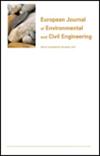Study on strong contact system by sub-network partitioning method for binary mixtures
IF 2.3
4区 工程技术
Q2 ENGINEERING, CIVIL
European Journal of Environmental and Civil Engineering
Pub Date : 2023-10-15
DOI:10.1080/19648189.2023.2268691
引用次数: 0
Abstract
AbstractThe contact network of binary mixtures can be divided into three contact sub-networks according to the branch vector length. A new method has been proposed for partitioning strong contact in binary mixtures. This method is based on the mean contact force of each sub-networks and is different from the conventional partitioning method, which is based on the mean contact force of the whole-network. A series of triaxial compression numerical tests were conducted on binary mixtures with different fine content (FC). The strong contact system in both the sub-network partitioning and the whole-network partitioning methods was studied. In some cases, certain coarse-coarse contacts that were identified as strong in the whole-network partitioning method were found to be weak in the sub-network partitioning method. Conversely, some coarse-fine and fine-fine contacts that were weak contacts in the whole-network partitioning method were identified as strong contacts in the sub-network partitioning method. In the sub-network partitioning method, the contribution of strong contacts to both axial and radial stress is lower than that observed in the whole-network partitioning method. Additionally, when considering branch vector length in the sub-network weighting parameters, there is a unique fabric-stress relationship was observed for different FC.Keywords: Binary mixturesdiscrete element methodstrong contact systemstrong contact partitioning methodfine content Data availability statementThe numerical data used in the current study are available from the corresponding author on reasonable request.Disclosure statementNo conflict of interest has been reported by the authors.Additional informationFundingThis work was supported by the National Natural Science Foundation of China (No.52278327) and Beijing Natural Science Foundation (No.8222020).二元混合物强接触系统的子网络划分方法研究
摘要二元混合接触网络根据分支向量的长度可分为三个接触子网络。提出了一种二元混合物中强接触分配的新方法。该方法基于各子网络的平均接触力,不同于传统的基于全网平均接触力的划分方法。对不同细粒含量的二元混合物进行了三轴压缩数值试验。对强接触系统在子网络分区和全网分区中的应用进行了研究。在某些情况下,在全网划分方法中被识别为强的某些粗-粗接触在子网划分方法中被发现是弱的。相反,一些在全网划分方法中属于弱接触的粗细接触和细细接触在子网划分方法中被识别为强接触。在子网络划分方法中,强接触对轴向和径向应力的贡献低于全网划分方法。此外,当考虑子网络权重参数中的分支向量长度时,不同FC的织物-应力关系是独特的。关键词:二元混合离散元法强接触系统强接触划分法精细内容数据可用性声明本研究中使用的数值数据应合理要求可从通讯作者处获得。披露声明作者未报告存在利益冲突。本研究得到国家自然科学基金(No.52278327)和北京市自然科学基金(No.8222020)的资助。
本文章由计算机程序翻译,如有差异,请以英文原文为准。
求助全文
约1分钟内获得全文
求助全文
来源期刊

European Journal of Environmental and Civil Engineering
ENGINEERING, CIVIL-ENGINEERING, GEOLOGICAL
CiteScore
4.80
自引率
4.80%
发文量
153
审稿时长
6 months
期刊介绍:
The European Research Area has now become a reality. The prime objective of the EJECE is to fully document advances in International scientific and technical research in the fields of sustainable construction and soil engineering. In particular regard to the latter, the environmental preservation of natural media (soils and rocks) and the mitigation of soil-related risks are now not only major societal challenges, but they are also the source of scientific and technical developments that could be extremely beneficial.
 求助内容:
求助内容: 应助结果提醒方式:
应助结果提醒方式:


